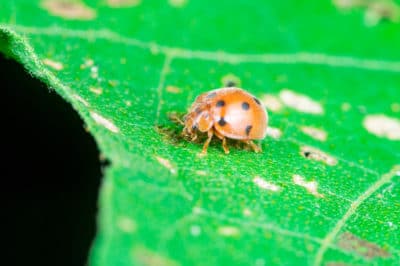About Mexican Bean Beetles
The Mexican bean beetle is a member of the same family as the ladybird beetle (also known as the ladybug). Unlike other members of the Coccinellidae, which are carnivorous, the Mexican bean beetle confines its attention to legumes. Believed to be native to the southern plateau region of Mexico, it is actually more of a problem in states east of the Rocky Mountains than its native land.
Recognizing the Pest
Mexican bean beetles are similar in appearance to the related ladybird beetle. However, they are typically more yellow to copper-brown in color. Eggs are pale yellow to orange yellow and found in clusters on the underside of bean leaves. The larvae are light yellow and slightly over one-sixteenth inch long when hatched. Mature larvae are greenish yellow and about one-third of an inch long.
Recognizing Damage
Both larvae and adults feed on the undersides of the leaves. As they feed, the leaves begin to take on a lacy appearance until only the veins are left. The edges of the holes turn yellow or brown. Sometimes, the beetle will also attack young pods and stems. Any kind of bean varieties may be attacked and damage is usually most severe in mid- to late summer.
Garden Sanitation
Mexican bean beetles overwinter in garden debris. They emerge in late to mid-spring when the weather begins to warm. Female beetles will begin to lay eggs with a week or two after they begin to feed. Keeping your garden clean is one of the most important things you can do to control this pest. Beggarweed is thought to be a host plant and should be removed.
Control Methods
Organic controls for Mexican bean beetles include:
- Cultural control – combine a trap crop with delayed planting of the main crop, or plant very early varieties.
- Biological controls – release predators to eat eggs and larvae.
- Choosing varieties – Beetles prefer bush beans over pole varieties.
- Hand pick – adults can be picked and dropped in soapy water. Remove egg clusters from leaves.
- Diatomacious earth – dust over crops; works on contact.
Insecticides
Organic gardeners do have options for the Mexican bean beetle. Safer’s soap sprays, if sprayed heavily on tops and bottom of leaves, may help with control. Neem oil is insecticidal and does not harm honey bees. A combined spray of Safer’s soap and neem oil may be more effective than either alone. Botanical insecticides such as pyrethrins and nicotine can be used as a last resort.
